Sandra Lahire and Celeste Burlina
Grazer Kunstverein, Graz
by Robin Waart
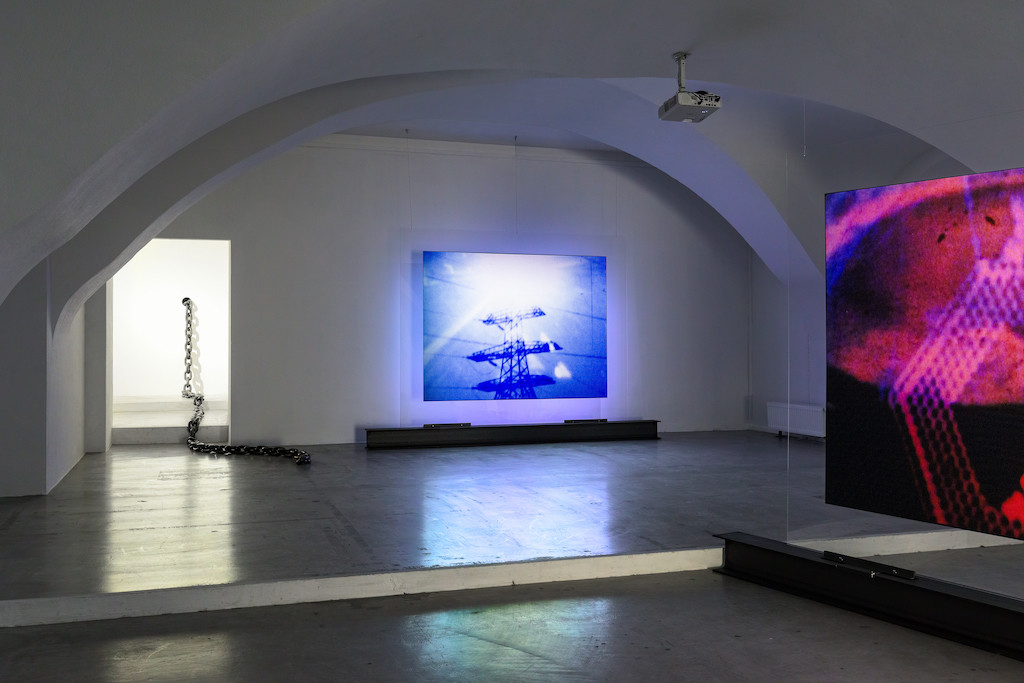
Sandra Lahire, Terminals, 1986, Plutonium Blonde, 1987, and Celeste Burlina, carrier, 2022. Installation view. we sat rigid except for the parts of our bodies that were needed for production, 2022, Grazer Kunstverein. Photo: kunst-dokumentation.com
“How do we archive a relationship?” artist Kerstin Schroedinger asks in the booklet accompanying we sat rigid except for the parts of our bodies that were needed for production, Sandra Lahire’s and Celeste Burlina’s exhibition at the Grazer Kunstverein [1], the first show and first volume in a series of postcard size publications comprised of “correspondence, responses, and conversations” collected by director and curator Tom Engels, who invited a panel of women specialists to discuss Lahire’s work and life.
The answer to the question depends on who the “we” is which it summons. By the kind of relationship implied, friendly, familiar, sexual, to oneself, to someone else. But also by what “archiving” and exhibiting can mean. To put away what is over and done with for parties involved, too heavy, too light to bear? Or else, to keep close at hand, more objectively, for posterity? Every archive is a place of possibility: of loss, for discoveries. Especially when, as is the case with Lahire, life and work are so interconnected, as someone with and ultimately dying of anorexia, a paragon of the feminist experimental film community, lesbian and queer activist, someone herself working with historical materials, as she did for her trilogy and doctoral research on Sylvia Plath. And when, as again is the case with Lahire, what is left for the archive is so astonishingly little, “her archival materials exist in people’s heads and personal correspondence” [2]. The exhibition of her films becomes a conversation (of the living) with the dead.
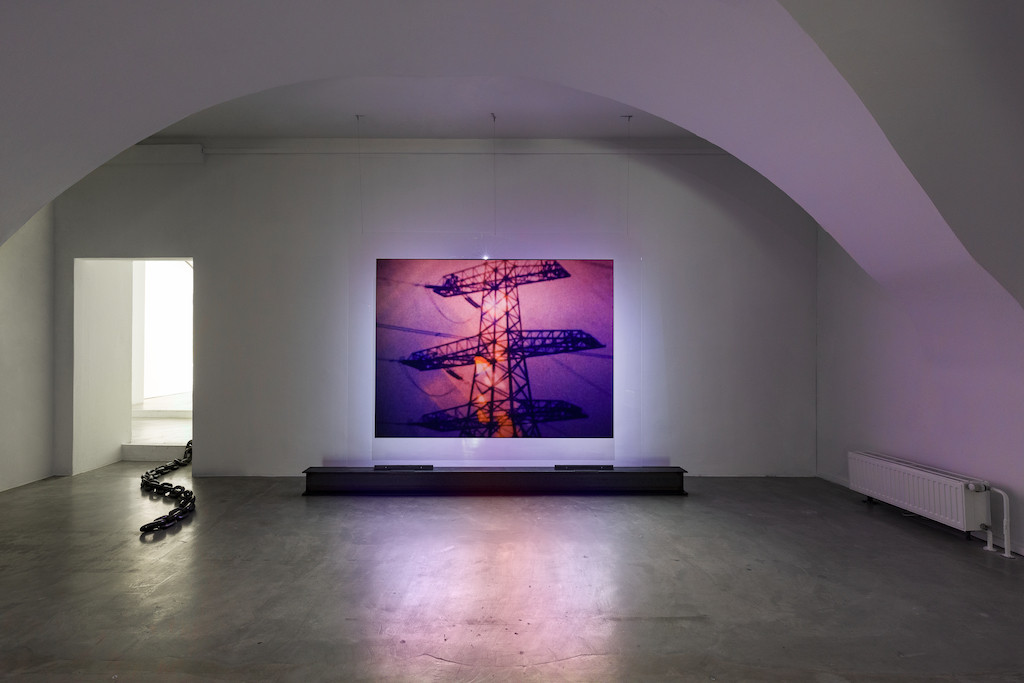
Sandra Lahire, Terminals, 1986, and Celeste Burlina, carrier, 2022. Installation view. we sat rigid except for the parts of our bodies that were needed for production, 2022, Grazer Kunstverein. Photo: kunst-dokumentation.com
The invitation to build a setting for the screening of Lahire’s cinematic work that Engels extended to Burlina reveals itself as both a response, as much as it becomes a call. The pairing of six films by Lahire from the 1980s with Celeste Burlina’s intervention carrier (2022) is not confusing but equal, even monumental. Beginning with a display of just the ‘support structure’ that she devised, in the first of the Kunstverein’s renovated spaces: a set of H-beams diagonally cutting, like a railroad track, from the lobby towards the first, darkened screening room. Three films, frontally by the farthest wall, sideways on acrylic plates mounted onto further beams, pulling the visitor in and leading them out of the first vaulted exhibition space to the next – anchored in between by parts and chunks of heavy lifting chains, loosely draped across the floor, the corridors, steps and the maze-like structure of the Kunstverein’s building with its different levels and ceilings. So bulky and strong they would drown a ship.
Burlina’s procedure is observing, not subservient. Never taking centre stage, even where the chain cuts through a wall, and huge drill bits stick right through it at different heights, from one side to the other. Perhaps, because what seems light and moving and has sound just seizes our attention first, before you notice the thread Burlina weaves is what leads you from the one space and film to the next, pulling you back just enough to take a distance and become aware: opposites attract. Tantamount in a way, the theme of weight and lightness running through the show like a thread. When Burlina, in an interview published in the booklet, states what she wanted is to “create a place that is vulnerable” [3] and give to women “freedom through destructive actions”, the no less piercing question is raised: why will some aggression go unnoticed?
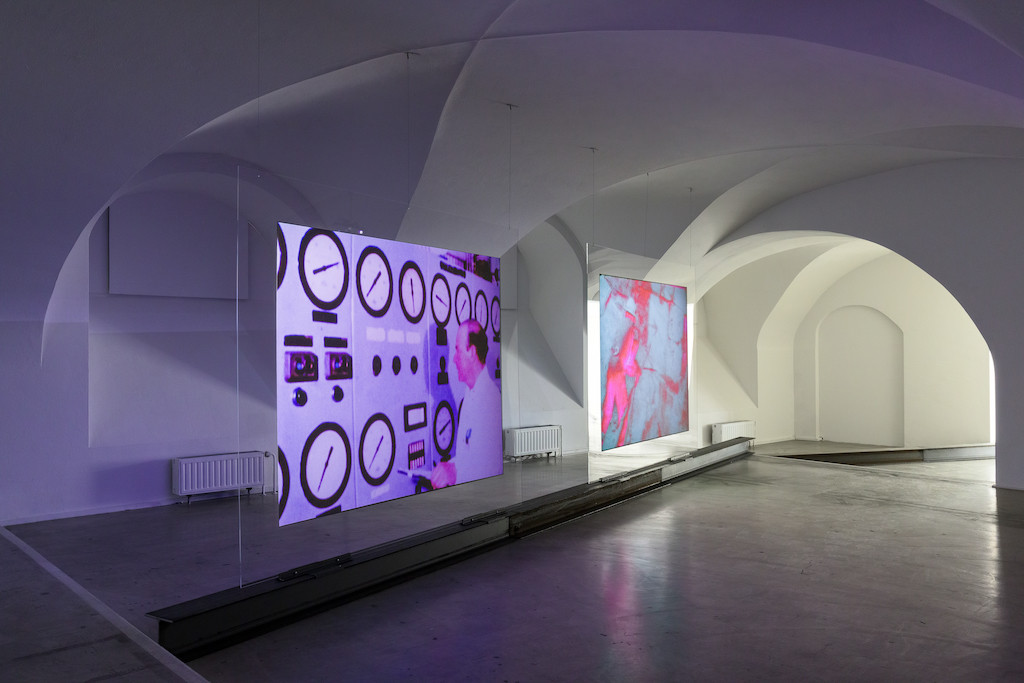
Sandra Lahire, Plutonium Blonde, 1987, Uranium Hex, 1987, and Celeste Burlina, carrier, 2022. Installation view. we sat rigid except for the parts of our bodies that were needed for production, 2022, Grazer Kunstverein. Photo: kunst-dokumentation.com.
This is (I fear) the plight of those cases, individuals and minorities, where aggression has nowhere to turn but inward and, strangely, become liberating. Both are topics at the root Lahire’s work and life, where she addresses anorexia, a woman’s role in society, labour inequalities, nuclear radiation. Interlocking these and other “invisible” forces on celluloid, overexposed, after and on top of each other, amplified, in acidic colours and to the voice of private, but universal distress, as she does in Arrows –Lahire’s first film, and the fourth in the exhibition’s setup–, through the 17-year old Kate’s words: “I don’t want to hide it anymore.”
This deepfelt and radical solidarity with the repressed and underrepresented is the premise of Lahire’s article, Lesbians in Media Education [4], making it nearly a pamphlet for inclusion and inclusivity when it was published in 1985 at the height of Margaret Thatcher’s ‘social’ reforms, ironically the second of the Iron Lady’s three terms as the UK’s first female prime minister. But also (I think) before the negative emancipation of eating disorders as something more and more men suffer from too. Why should there be less of one? Anorexia requires a drive that is willing, desperate to cut, ignoring, perhaps accepting the collaterals.

Sandra Lahire, Arrows, 1984, and Celeste Burlina, carrier, 2022. Installation view. we sat rigid except for the parts of our bodies that were needed for production, 2022, Grazer Kunstverein. Photo: kunst-dokumentation.com
Burlina’s hard steel objects literally balance the heavy subjects and concerns, personal and political, that Lahire put into motion almost four decades ago in films that seem to be on the verge of disappearing and degradation, a time-based, ghostly material that becomes bodily without showing us bodies all the time. Indeed there is power –at least empowerment– in destruction. If the weight of the one’s work gently nods at the stones that sank Virginia Woolf, the lightness of the other’s reminds of the unthinkable gas killing Plath, her image poisoned blurry green, before it blends and morphs into a photograph of a cat or footage of Lahire herself (Edge, 1986).
Both the films and the exhibition itself become a place, a state, you do and do not want to be in, painfully attractive and identifiable, a double discovery. Titled analphabetically and organized nonchronologically, the exhibition opens with Uranium Hex (1987), the first of Lahire’s “nuclear trilogy”, and its soundtrack is met somewhere in the middle by that of Serpent River (1989), the last film in the show. In this way, the two films’ audio overarch, blurring the separate pieces and (dis)connected rooms. At the same time, each of them can be listened to on headphones, individually, or contemplated to the sound of one another.
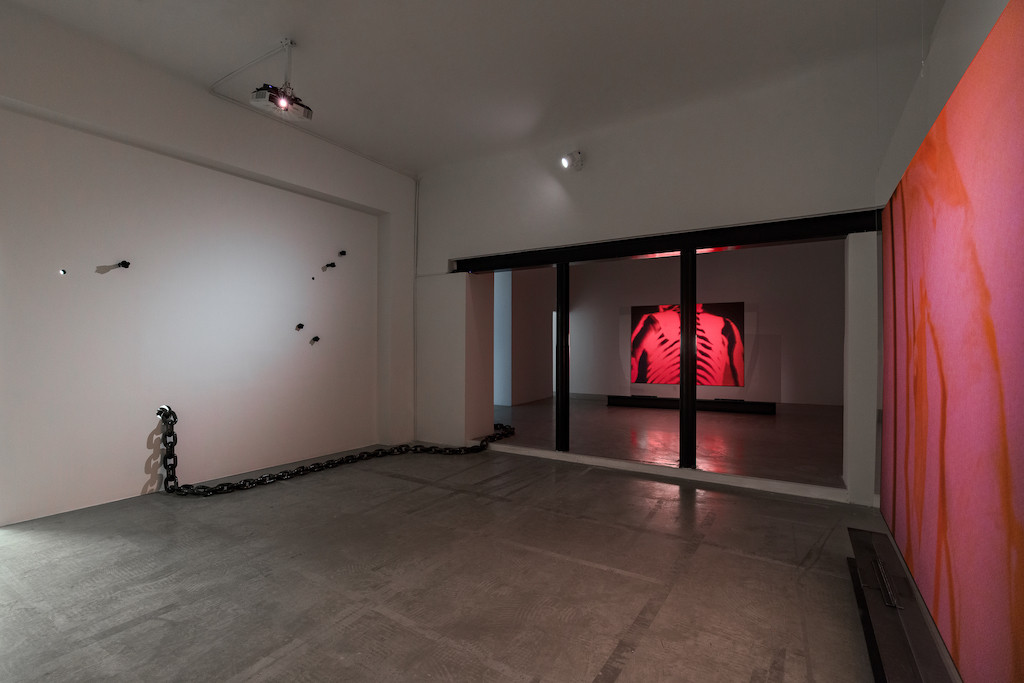
Sandra Lahire, Serpent River, 1989, Arrows, 1984,and Celeste Burlina, carrier, 2022. Installation view. we sat rigid except for the parts of our bodies that were needed for production, 2022, Grazer Kunstverein. Photo: kunst-dokumentation.com
The booklet’s grey metallic cover speaks in the same voice, an italicised serif font stressing the meandering positioning of the works and thought complexes it presents and is supplemented by a small white name card with only the exhibition title and dates on it, a black-on-silver exhibition sketch of the chain and drill bits piercing an imaginary wall, and a folded full-colour exhibition poster with stills from Edge and Serpent River. What is unearthed here is consciously not straightforward, but that connections and relations are upkept, remade, an archive of extended ephemera.
I wondered if the things we do not or can not write about have more value, actually mean more, compared to all the things we know to keep. It is as if, when Lahire superimposes images, the blur cuts right to the point, the point of a story, to that which you can and can not find or summarise, but keep on trying to. I wondered, in other words, if the lean archive is a strategy. An exhibited relationship, a stage as we sat rigid except for the parts of our bodies that were needed for production proposes is something, a place that we can all have, whether you make it to Graz or not [5], because it comes from just as much as it continues the archive and the surplus that engaging with it anew brings forth, through (the invitation to) an exhibition, a program, a publication, a review.
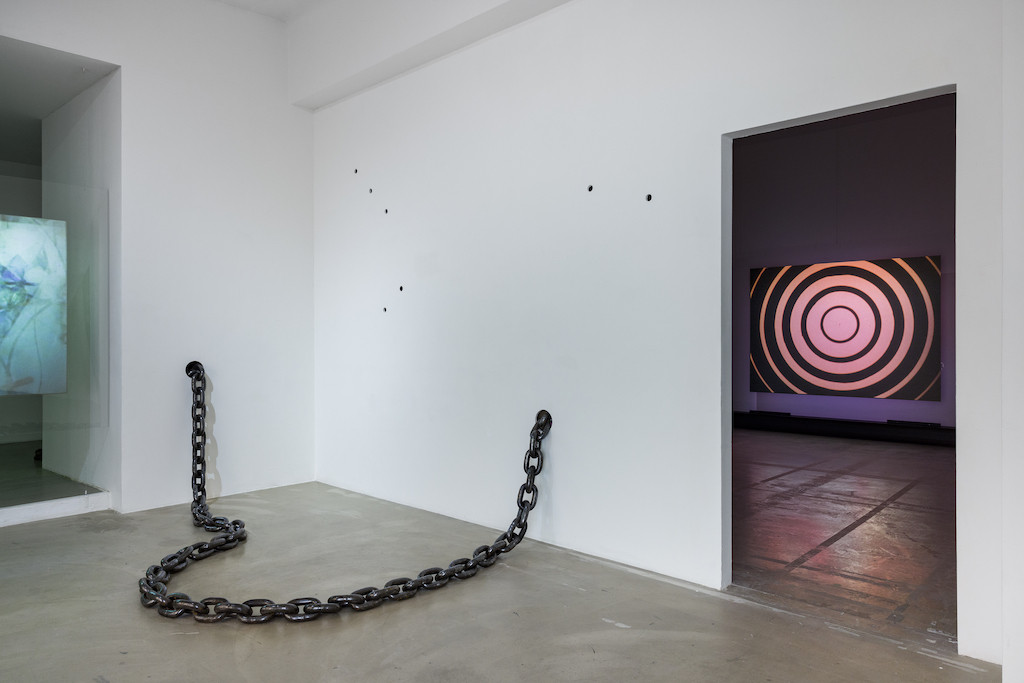
Sandra Lahire, Arrows, 1984, and Celeste Burlina, carrier, 2022. Installation view. we sat rigid except for the parts of our bodies that were needed for production, 2022, Grazer Kunstverein. Photo: kunst-dokumentation.com
The socio-political mess we are in now is often traced back to what governments in the Global West set into motion during the 1980s and 90s: austerities, privatisations, cutbacks marked and masked as self-reliance or market economy, and the extremely slow response to the aids pandemic. The struggle against this mindset, the moment she is speaking to and what as a feminist filmmaker she is fighting for in 1985, some two years before Margaret Thatcher’s infamous remark that there is “no such thing as society” [6] resonates in Lahire’s Lesbians in Media Education – “One may ask, are our identities really so bound up with sexual choice? The human essence is the assembly of social relations, and sexuality is social relations” [7].
Maybe relationships just don’t want to be archived.
Sandra Lahire and Celeste Burlina
we sat rigid except for the parts of our bodies that were needed for production
09/04 – 29/05/2022
Grazer Kunstverein
Burggasse 4, 8010
Graz, Austria
Celeste Burlina, Tom Engels, Laura Guy, Calla Henkel, Sandra Lahire, Julie Peeters, Charlotte Procter, Kerstin Schroedinger, Miriam Stoney.
[1] Laura Guy, Charlotte Procter, Kerstin Schroedinger & Tom Engels, ‘Conversation’, in we sat rigid except for the parts of our bodies that were needed for production, Sandra Lahire and Celeste Burlina (ed. Tom Engels). Grazer Kunstverein, Graz 2022, p. 44
[2] ‘Conversation’, p. 44. This remark in the conversation is by Charlotte Procter.
[3] Celeste Burlina & Miriam Stoney, ‘Down-the-hole’. Ibid, p. 19 and 20
[4] Sandra Lahire, ‘Lesbians in Media Education’ in Undercut (Summer 1985) and included in Visibly Female: Feminism and Art (1987), https://issuu.com/courtisanefestival/docs/cahier_sandra_lahire/s/13692838
[5] Unfortunately none of Lahire’s films can currently be viewed anywhere online.
[6] Margarat Thatcher interviewed by Douglas Keay for Woman’s Own, published 31 October 1987 under the title ‘Aids, education and the year 2000!’, https://www.margaretthatcher.org/document/106689
[7] Sandra Lahire, ‘Lesbians in Media Education’ in Undercut (Summer 1985) and included in Visibly Female: Feminism and Art (1987), https://issuu.com/courtisanefestival/docs/cahier_sandra_lahire/s/13692838